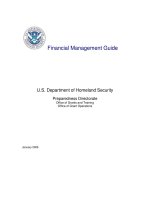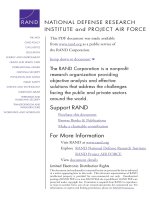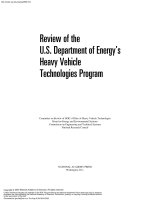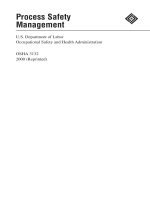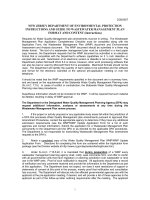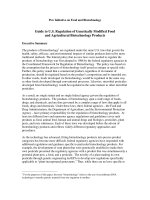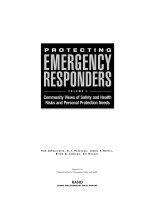Process Safety Management U.S. Department of Labor Occupational Safety and Health Administration pptx
Bạn đang xem bản rút gọn của tài liệu. Xem và tải ngay bản đầy đủ của tài liệu tại đây (199.29 KB, 59 trang )
Process Safety
Management
U.S. Department of Labor
Occupational Safety and Health Administration
OSHA 3132
2000 (Reprinted)
This informational booklet is
intended to provide a generic,
non-exhaustive overview of a
particular standards-related topic.
This publication does not itself
alter or determine compliance
responsibilities, which are set
forth in OSHA standards them-
selves and the Occupational
Safety and Health Act. Moreover,
because interpretations and
enforcement policy may change
over time, for additional guidance
on OSHA compliance require-
ments, the reader should consult
current and administrative inter-
pretations and decisions by
the Occupational Safety and
Health Review Commission
and the Courts.
Material contained in this publica-
tion is in the public domain and
may be reproduced, fully or
partially, without permission
of the Federal Government.
Source credit is requested but
not required.
This information will be made
available to sensory impaired
individuals upon request.
Voice phone: (202) 693-1999
Process Safety
Management
U.S. Department of Labor
Alexis M. Herman, Secretary
Occupational Safety and Health Administration
Charles N. Jeffress, Assistant Secretary
OSHA 3132
2000 (Reprinted)
Contents
Contents
iii
The Problem 1
How the Standard Works 5
Process Safety Information 7
Process Hazard Analysis 9
Operating Procedures 12
Employee Participation 14
Training 15
Initial Training 15
Refresher Training 15
Training Documentation 15
Contractors 16
Application 16
Employer Responsibilities 16
Contract Employer Responsibilities 16
Pre-Startup Safety Review 18
Mechanical Integrity 19
Hot Work Permit 21
Management of Change 22
Incident Investigation 23
Emergency Planning and Response 24
Compliance Audits 25
Trade Secrets 26
Part 1910-Occupational Safety and Health Standards 27
§ 1910.109 Explosives and Blasting Agents 27
§ 1910.119 Process Safety Management of
Highly Hazardous Chemicals 28
Appendix A - List of Highly Hazardous Chemicals,
Toxics and Reactives (Mandatory) 42
Appendix B - Block Flow Diagram and Simplified Process
Flow Diagram (Nonmandatory) 46
OSHA Consultation Directory 48
States With Approved Plans 50
Related Publications 54
The Problem
The Problem
1
Unexpected releases of toxic, reactive, or flammable liquids and
gases in processes involving highly hazardous chemicals have been
reported for many years. Incidents continue to occur in various
industries that use highly hazardous chemicals which may be toxic,
reactive, flammable, or explosive, or may exhibit a combination of
these properties. Regardless of the industry that uses these highly
hazardous chemicals, there is a potential for an accidental release any
time they are not properly controlled. This, in turn, creates the
possibility of disaster.
Recent major disasters include the 1984 Bhopal, India, incident
resulting in more than 2,000 deaths; the October 1989 Phillips
Petroleum Company, Pasadena, TX, incident resulting in 23 deaths
and 132 injuries; the July 1990 BASF, Cincinnati, OH, incident
resulting in 2 deaths, and the May 1991 IMC, Sterlington, LA,
incident resulting in 8 deaths and 128 injuries.
Although these major disasters involving highly hazardous
chemicals drew national attention to the potential for major catastro-
phes, the public record is replete with information concerning many
other less notable releases of highly hazardous chemicals. Hazard-
ous chemical releases continue to pose a significant threat to employ-
ees and provide impetus, internationally and nationally, for authori-
ties to develop or consider developing legislation and regulations to
eliminate or minimize the potential for such events.
On July 17, 1990, OSHA published in the Federal Register (55 FR
29150) a proposed standard,—”Process Safety Management of
Highly Hazardous Chemicals”—containing requirements for the
management of hazards associated with processes using highly
hazardous chemicals to help assure safe and healthful workplaces.
OSHA’s proposed standard emphasized the management of
hazards associated with highly hazardous chemicals and established
a comprehensive management program that integrated technologies,
procedures, and management practices.
The notice of proposed rulemaking invited comments on any
aspect of the proposed standard for process safety management of
highly hazardous chemicals and announced the scheduling of a
hearing to begin on November 27, 1990, in Washington, DC.
On November 1, 1990, OSHA published a Federal Register notice
(55 FR 46074) scheduling a second hearing to begin on February 26,
Process Safety Management
2
1991, in Houston, TX, enumerating additional issues, and extending
the written comment period until January 22, 1991.
The hearings on the proposed standard were held in Washington,
DC, from November 27, 1990, through December 4, 1990, and in
Houston, TX, from February 26, 1991, through March 7, 1991. The
Administrative Law Judge presiding at the hearings allowed partici-
pants to submit post-hearing comments until May 6, 1991, and file
post-hearing briefs until June 5, 1991. OSHA received more than
175 comments in response to the notice of proposed rulemaking. In
addition to these comments, the hearings resulted in almost 4,000
pages of testimony and almost 60 post-hearing comments and briefs.
For readers’ convenience, this publication includes, as an appendix,
the full text of the final OSHA standard issued in the Federal Regis-
ter on February 24, 1992, including the list of covered chemicals and
threshold amounts.
State plan States, approved under section 18(b) of the Occupa-
tional Safety and Health Act of 1970 (see list on page 36) must adopt
standards and enforce requirements which are at least as effective as
Federal requirements. There are currently 25 State plan States; 23
covering private and public (State and local government) sectors and
two covering public sector only. Plan States must adopt comparable
standards to the Federal within six months of a Federal standard’s
promulgation.
Approximately four months after the publication of OSHA’s
proposed standard for process safety management of highly hazard-
ous chemicals, the Clean Air Act Amendments (CAAA) were
enacted into law (November 15, 1990). Section 304 of the CAAA
requires that the Secretary of Labor, in coordination with the Admin-
istrator of the Environmental Protection Agency (EPA), promulgate,
pursuant to the Occupational Safety and Heath Act of 1970, a
chemical process safety standard to prevent accidental releases of
chemicals that could pose a threat to employees.
The CAAA requires that the standard include a list of highly
hazardous chemicals which includes toxic, flammable, highly
reactive, and explosive substances. The CAAA also specified
minimum elements that the OSHA standard must require employers
to do, as follows:
3
The Problem
(1) Develop and maintain written safety information identifying
workplace chemical and process hazards, equipment used in the
processes, and technology used in the processes;
(2) Perform a workplace hazard assessment, including, as appro-
priate, identification of potential sources of accidental releases,
identification of any previous release within the facility that had a
potential for catastrophic consequences in the workplace, estimation
of workplace effects of a range of releases, and estimation of the
health and safety effects of such a range on employees;
(3) Consult with employees and their representatives on the
development and conduct of hazard assessments and the develop-
ment of chemical accident prevention plans and provide access to
these and other records required under the standard;
(4) Establish a system to respond to the workplace hazard assess-
ment findings, which shall address prevention, mitigation, and
emergency responses;
(5) Review periodically the workplace hazard assessment and
response system;
(6) Develop and implement written operating procedures for the
chemical processes, including procedures for each operating phase,
operating limitations, and safety and health considerations;
(7) Provide written safety and operating information for employ-
ees and employee training in operating procedures, by emphasizing
hazards and safe practices that must be developed and made avail-
able;
(8) Ensure contractors and contract employees are provided with
appropriate information and training;
(9) Train and educate employees and contractors in emergency
response procedures in a manner as comprehensive and effective as
that required by the regulation promulgated pursuant to section
126(d) of the Superfund Amendments and Reauthorization Act;
(10) Establish a quality assurance program to ensure that initial
process-related equipment, maintenance materials, and spare parts
are fabricated and installed consistent with design specifications;
Process Safety Management
4
(11) Establish maintenance systems for critical process-related
equipment, including written procedures, employee training, appro-
priate inspections, and testing of such equipment to ensure ongoing
mechanical integrity;
(12) Conduct pre-startup safety reviews of all newly installed or
modified equipment;
(13) Establish and implement written procedures managing
change to process chemicals, technology, equipment and facilities;
and
(14) Investigate every incident that results in or could have re-
sulted in a major accident in the workplace, with any findings to be
reviewed by operating personnel and modifications made, if appro-
priate.
Also the CAAA, identifies specific duties for EPA relative to the
prevention of accidental releases (see section 301 (r)). Generally,
EPA must develop a list of chemicals and a Risk Management Plan.
How the Standard Works
5
Process Safety Information
This booklet summarizes the OSHA final process safety manage-
ment (PSM) standard. Employers and employees may prefer to read
this booklet and a companion one entitled, “Process Safety Manage-
ment - Guidelines for Compliance” (OSHA 3133), before studying
the rule itself.
The standard mainly applies to manufacturing industries—par-
ticularly, those pertaining to chemicals, transportation equipment,
and fabricated metal products. Other affected sectors include natural
gas liquids; farm product warehousing; electric, gas, and sanitary
services; and wholesale trade. It also applies to pyrotechnics and
explosives manufacturers covered under other OSHA rules and has
special provisions for contractors working in covered facilities.
In each industry, PSM applies to those companies that deal with
any of more than 130 specific toxic and reactive chemicals in listed
quantities; it also includes flammable liquids and gases in quantities
of 10,000 pounds (4,535.9 Kg) or more.
Subject to the rules and procedures set forth in OSHA’s Hazard
Communication Standard (29 Code of Federal Regulations (CFR)
1910.1200(i)(1) through 1910.1200(i)(12)), employees and their
designated representatives must be given access to trade secret
information contained within the process hazard analysis and other
documents required to be developed by the PSM standard.
The key provision of PSM is process hazard analysis (PHA)—a
careful review of what could go wrong and what safeguards must be
implemented to prevent releases of hazardous chemicals. Covered
employers must identify those processes that pose the greatest risks
and begin evaluating those first. PHAs must be completed as soon as
possible. At least one-quarter of the processes must be evaluated by
May 26, 1994, with an additional 25 percent completed each follow-
ing year so that by May 26, 1997, if not sooner, employers will have
evaluated all affected processes. PSM clarifies the responsibilities of
employers and contractors involved in work that affects or takes
place near covered processes to ensure that the safety of both plant
and contractor employees is considered. The standard also mandates
written operating procedures; employee training; prestartup safety
reviews; evaluation of mechanical integrity of critical equipment; and
written procedures for managing change. PSM specifies a permit
system for hot work; investigation of incidents involving releases or
Process Safety Management
6
near misses of covered chemicals; emergency, action plans; compli-
ance audits at least every three years; and trade secret protection.
To understand PSM and its requirements, employers and employ-
ees need to understand how OSHA uses the term “process” in PSM.
Process means any activity involving a highly hazardous chemical
including using, storing, manufacturing, handling, or moving such
chemicals at the site, or any combination of these activities. For
purposes of this definition, any group of vessels that are intercon-
nected, and separate vessels located in a way that could involve a
highly hazardous chemical in a potential release, are considered a
single process.
Process Safety Information
7
Process Safety Information
Employers must complete a compilation of written process safety
information before conducting any process hazard analysis required
by the standard. The compilation of written process safety informa-
tion, completed under the same schedule required for process hazard
analyses, will help the employer and the employees involved in
operating the process to identify and understand the hazards posed
by those processes involving highly hazardous chemicals. Process
safety information must include information on the hazards of the
highly hazardous chemicals used or produced by the process, infor-
mation on the technology of the process, and information on the
equipment in the process.
Information on the hazards of the highly hazardous chemicals in
the process shall consist of at least the following:
1
• Toxicity,
• Permissible exposure limits,
• Physical data,
• Reactivity data,
• Corrosivity data, and
• Thermal and chemical stability data, and hazardous effects of
inadvertent mixing of different materials.
Information on the technology of the process must include at least
the following:
• A block flow diagram or simplified process flow diagram,
• Process chemistry,
• Maximum intended inventory,
• Safe upper and lower limits for such items as temperatures,
pressures, flows or compositions, and
• An evaluation of the consequences of deviations, including
those affecting the safety and health of employees.
Where the original technical information no longer exists, such
information may be developed in conjunction with the process
hazard analysis in sufficient detail to support the analysis.
1
Note: Material Safety Data Sheets (MSDSs) meeting the requirements of the
Hazard Communication Standard (20 CFR 1910.1200) may be used to comply with
this requirement to the extent they contain the required information.
Process Safety Management
8
Information on the equipment in the process must include the
following:
• Materials of construction,
• Piping and instrument diagrams (P&IDs),
• Electrical classification,
• Relief system design and design basis,
• Ventilation system design,
• Design codes and standards employed,
• Material and energy balances for processes built after May 26,
1992, and
• Safety systems (e.g., interlocks, detection, or suppression
systems).
The employer shall document that equipment complies with
recognized and generally accepted good engineering practices. For
existing equipment designed and constructed in accordance with
codes, standards, or practices that are no longer in general use, the
employer shall determine and document that the equipment is
designed, maintained, inspected, tested, and operated in a safe
manner.
The compilation of the above described process safety information
provides the basis for identifying and understanding the hazards of a
process and is necessary in developing the process hazard analysis
and may be necessary for complying with other provisions of PSM
such as management of change and incident investigations.
9
Process Hazard Analysis
Process Hazard Analysis
The process hazard analysis is a thorough, orderly, systematic
approach for identifying, evaluating, and controlling the hazards of
processes involving highly hazardous chemicals. The employer must
perform an initial process hazard analysis (hazard evaluation) on all
processes covered by this standard. The process hazard analysis
methodology selected must be appropriate to the complexity of the
process and must identify, evaluate, and control the hazards involved
in the process.
First, employers must determine and document the priority order
for conducting process hazard analyses based on a rationale that
includes such considerations as the extent of the process hazards, the
number of potentially affected employees, the age of the process, and
the operating history of the process. All initial process hazard
analyses should be conducted as soon as possible, but at a minimum,
the employer must complete no fewer than 25 percent by May 26,
1994; 50 percent by May 26, 1995; 75 percent by May 26, 1996; and
all initial process hazard analyses by May 26, 1997. Where there is
only one process in a workplace, the analysis must be completed by
May 26, 1994.
Process hazard analyses completed after May 26, 1987, that meet
the requirements of the PSM standard are acceptable as initial
process hazard analyses. All process hazard analyses must be
updated and revalidated, based on their completion date, at least
every five years.
The employer must use one or more of the following methods, as
appropriate, to determine and evaluate the hazards of the process
being analyzed:
• What-if,
• Checklist,
• What-if/checklist,
• Hazard and operability study (HAZOP),
• Failure mode and effects analysis (FMEA),
• Fault tree analysis, or
• An appropriate equivalent methodology.
Process Safety Management
10
A discussion of these methods of analysis is contained in the
companion publication, OSHA 3133, Process Safety Management -
Guidelines for Compliance. Whichever method(s) are used, the
process hazard analysis must address the following:
• The hazards of the process;
• The identification of any previous incident that had a potential
for catastrophic consequences in the workplace;
• Engineering and administrative controls applicable to the
hazards and their interrelationships, such as appropriate appli-
cation of detection methodologies to provide early warning of
releases. Acceptable detection methods might include process
monitoring and control instrumentation with alarms, and
detection hardware such as hydrocarbon sensors;
• Consequences of failure of engineering and administrative
controls;
• Facility siting;
• Human factors; and
• A qualitative evaluation of a range of the possible safety and
health effects on employees in the workplace if there is a failure
of controls.
OSHA believes that the process hazard analysis is best performed
by a team with expertise in engineering and process operations, and
that the team should include at least one employee who has experi-
ence with and knowledge of the process being evaluated. Also, one
member of the team must be knowledgeable in the specific analysis
methods being used.
The employer must establish a system to address promptly the
team’s findings and recommendations; ensure that the recommenda-
tions are resolved in a timely manner and that the resolutions are
documented; document what actions are to be taken; develop a
written schedule of when these actions are to be completed; complete
actions as soon as possible; and communicate the actions to operat-
ing, maintenance, and other employees whose work assignments are
in the process and who may be affected by the recommendations or
actions.
11
Process Hazard Analysis
At least every five years after the completion of the initial process
hazard analysis, the process hazard analysis must be updated and
revalidated by a team meeting the standard’s requirements to ensure
that the hazard analysis is consistent with the current process.
Employers must keep on file and make available to OSHA, on
request, process hazard analyses and updates or revalidation for each
process covered by PSM, as well as the documented resolution of
recommendations, for the life of the process.
Process Safety Management
12
Operating Procedures
The employer must develop and implement written operating
procedures, consistent with the process safety information, that
provide clear instructions for safely conducting activities involved in
each covered process. OSHA believes that tasks and procedures
related to the covered process must be appropriate, clear, consistent,
and most importantly, well communicated to employees. The
procedures must address at least the following elements:
Steps for each operating phase:
• Initial startup;
• Normal operations;
• Temporary operations;
• Emergency shutdown, including the conditions under which
emergency shutdown is required, and the assignment of shut
down responsibility to qualified operators to ensure that emer
gency shutdown is executed in a safe and timely manner;
• Emergency operations;
• Normal shutdown; and
• Startup following a turnaround, or after an emergency shut-
down.
Operating limits:
• Consequences of deviation, and
• Steps required to correct or avoid deviation.
Safety and health considerations:
• Properties of, and hazards presented by, the chemicals used in
the process;
• Precautions necessary to prevent exposure, including engineer-
ing controls, administrative controls, and personal protective
equipment;
• Control measures to be taken if physical contact or airborne
exposure occurs;
• Quality control for raw materials and control of hazardous
chemical inventory levels; and
• Any special or unique hazards.
• Safety systems (e.g., interlocks, detection or suppression
systems) and their functions.
13
Operating Procedures
To ensure that a ready and up-to-date reference is available, and to
form a foundation for needed employee training, operating proce-
dures must be readily accessible to employees who work in or
maintain a process. The operating procedures must be reviewed as
often as necessary to ensure that they reflect current operating
practices, including changes in process chemicals, technology, and
equipment, and facilities. To guard against outdated or inaccurate
operating procedures, the employer must certify annually that these
operating procedures are current and accurate.
The employer must develop and implement safe work practices to
provide for the control of hazards during work activities such as
lockout/tagout; confined space entry; opening process equipment or
piping; and control over entrance into a facility by maintenance,
contractor, laboratory, or other support personnel. These safe work
practices must apply both to employees and to contractor employees.
Process Safety Management
14
Employee Participation
Employers must develop a written plan of action to implement the
employee participation required by PSM. Under PSM, employers
must consult with employees and their representatives on the conduct
and development of process hazard analyses and on the development
of the other elements of process management, and they must provide
to employees and their representatives access to process hazard
analyses and to all other information required to be developed by the
standard.
15
Training
Training
Initial Training
OSHA believes that the implementation of an effective training
program is one of the most important steps that an employer can take
to enhance employee safety. Accordingly, PSM requires that each
employee presently involved in operating a process or a newly
assigned process must be trained in an overview of the process and in
its operating procedures. The training must include emphasis on the
specific safety and health hazards of the process, emergency opera-
tions including shutdown, and other safe work practices that apply to
the employee’s job tasks. Those employees already involved in
operating a process on the PSM effective date do not necessarily
need to be given initial training. Instead, the employer may certify in
writing that the employees have the required knowledge, skills, and
abilities to safely carry out the duties and responsibilities specified in
the operating procedures.
Refresher Training
Refresher training must be provided at least every three years, or
more often if necessary, to each employee involved in operating a
process to ensure that the employee understands and adheres to the
current operating procedures of the process. The employer, in
consultation with the employees involved in operating the process,
must determine the appropriate frequency of refresher training.
Training Documentation
The employer must determine whether each employee operating a
process has received and understood the training required by PSM.
A record must be kept containing the identity of the employee, the
date of training, and how the employer verified that the employee
understood the training.
Process Safety Management
16
Contractors
Application
Many categories of contract labor may be present at a jobsite; such
workers may actually operate the facility or do only a particular
aspect of a job because they have specialized knowledge or skill.
Others work only for short periods when there is need for increased
staff quickly, such as in turnaround operations. PSM includes special
provisions for contractors and their employees to emphasize the
importance of everyone taking care that they do nothing to endanger
those working nearby who may work for another employer.
PSM, therefore, applies to contractors performing maintenance or
repair, turnaround, major renovation, or specialty work on or adja-
cent to a covered process. It does not apply, however, to contractors
providing incidental services that do not influence process safety,
such as janitorial, food and drink, laundry, delivery, or other supply
services.
Employer Responsibilities
When selecting a contractor, the employer must obtain and
evaluate information regarding the contract employer’s safety
performance and programs. The employer also must inform contract
employers of the known potential fire, explosion, or toxic release
hazards related to the contractor’s work and the process; explain to
contract employers the applicable provisions of the emergency action
plan; develop and implement safe work practices to control the
presence, entrance, and exit of contract employers and contract
employees in covered process areas; evaluate periodically the perfor-
mance of contract employers in fulfilling their obligations; and
maintain a contract employee injury and illness log related to the
contractor’s work in the process areas.
Contract Employer Responsibilities
The contract employer must:
• Ensure that contract employees are trained in the work practices
necessary to perform their job safely;
17
• Ensure that contract employees are instructed in the known
potential fire, explosion, or toxic release hazards related to their
job and the process, and in the applicable provisions of the
emergency action plan;
• Document that each contract employee has received and
understood the training required by the standard by preparing a
record that contains the identity of the contract employee, the
date of training, and the means used to verify that the employee
understood the training;
• Ensure that each contract employee follows the safety rules of
the facility including the required safe work practices required
in the operating procedures section of the standard; and
• Advise the employer of any unique hazards presented by the
contract employer’s work.
Training
Process Safety Management
18
Pre-Startup Safety Review
It is important that a safety review takes place before any highly
hazardous chemical is introduced into a process. PSM, therefore,
requires the employer to perform a pre-startup safety review for new
facilities and for modified facilities when the modification is signifi-
cant enough to require a change in the process safety information.
Prior to the introduction of a highly hazardous chemical to a process,
the pre-startup safety review must confirm that the following:
• Construction and equipment are in accordance with design
specifications;
• Safety, operating, maintenance, and emergency procedures are
in place and are adequate;
• A process hazard analysis has been performed for new facilities
and recommendations have been resolved or implemented
before startup, and modified facilities meet the management of
change requirements; and
• Training of each employee involved in operating a process has
been completed.
Pre-Startup Safety Review
19
OSHA believes it is important to maintain the mechanical integ-
rity of critical process equipment to ensure it is designed and in-
stalled correctly and operates properly. PSM mechanical integrity
requirements apply to the following equipment:
• Pressure vessels and storage tanks;
• Piping systems (including piping components such as valves);
• Relief and vent systems and devices;
• Emergency shutdown systems;
• Controls (including monitoring devices and sensors, alarms,
and interlocks); and
• Pumps.
The employer must establish and implement written procedures to
maintain the ongoing integrity of process equipment. Employees
involved in maintaining the ongoing integrity of process equipment
must be trained in an overview of that process and its hazards and
trained in the procedures applicable to the employees’s job tasks.
Inspection and testing must be performed on process equipment,
using procedures that follow recognized and generally accepted good
engineering practices. The frequency of inspections and tests of
process equipment must conform with manufacturers’ recommenda-
tions and good engineering practices, or more frequently if deter-
mined to be necessary by prior operating experience. Each inspec-
tion and test on process equipment must be documented, identifying
the date of the inspection or test, the name of the person who per-
formed the inspection or test, the serial number or other identifier of
the equipment on which the inspection or test was performed, a
description of the inspection or test performed, and the results of the
inspection or test.
Equipment deficiencies outside the acceptable limits defined by
the process safety information must be corrected before further use.
In some cases, it may not be necessary that deficiencies be corrected
before further use, as long as deficiencies are corrected in a safe and
timely manner, when other necessary steps are taken to ensure safe
operation.
In constructing new plants and equipment, the employer must
ensure that equipment as it is fabricated is suitable for the process
application for which it will be used. Appropriate checks and
Mechanical Integrity
Mechanical Integrity
Process Safety Management
20
inspections must be performed to ensure that equipment is installed
properly and is consistent with design specifications and the
manufacturer’s instructions.
The employer also must ensure that maintenance materials, spare
parts, and equipment are suitable for the process application for
which they will be used.
States with Approved Plans
21Hot Work Permit
Hot Work Permit
A permit must be issued for hot work operations conducted on or
near a covered process. The permit must document that the fire
prevention and protection requirements in OSHA regulations
(1910.252(a)) have been implemented prior to beginning the hot
work operations; it must indicate the date(s) authorized for hot work;
and identify the object on which hot work is to be performed. The
permit must be kept on file until completion of the hot work.
